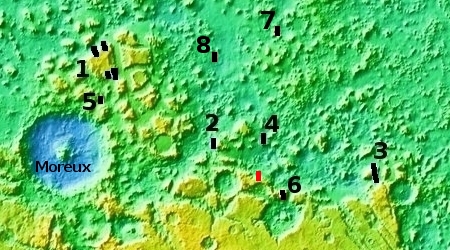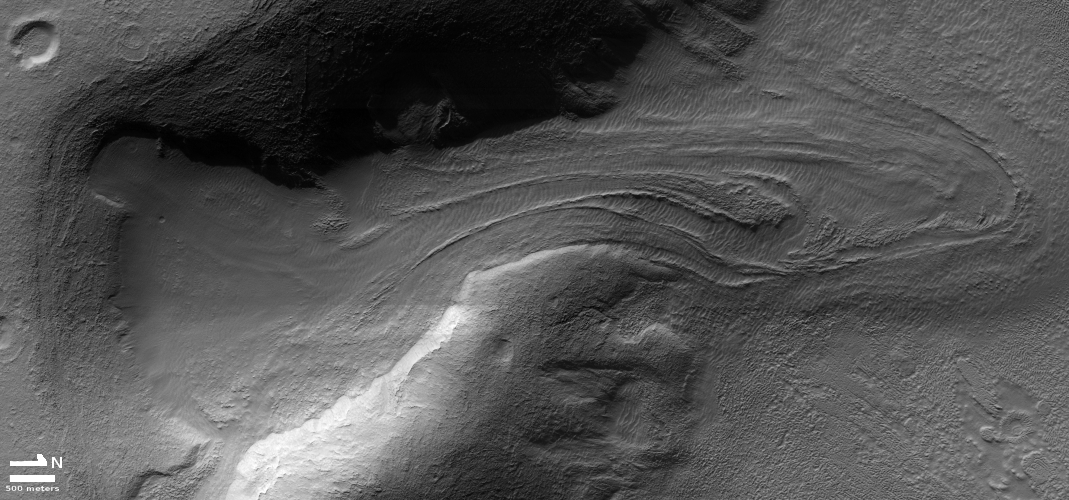A thick and syrupy flow on Mars

Cool image time! The photo above, rotated, cropped, and reduced to post here, was taken on March 5, 2022 by the high resolution camera on Mars Reconnaissance Orbiter (MRO). It shows what the scientists label as a “viscous flow feature,” which is another way of saying the flow was thick and syrupy.
Nor is such a flow unusual in this area of Mars. It is located in a region of chaos terrain dubbed Protonilus Mensae, which is also the central mensae region in the 2,000-mile-long strip in the northern mid-latitudes of Mars I label glacier country. The overview map above of Protonilus Mensae — covering about 500 miles in width — shows how common such flows are in this place. The black rectangles mark the locations of other cool images I have featured, as follows:
- 1. Buried glaciers flowing off of Martian mesa
- 2. Brain Terrain on Mars
- 3. How to spot a glacier on Mars
- 4. Glacier country on Mars
- 5. Revisiting Mars’ glacier country
- 6. Back to Mars’ glacier country
- 7. A cracking Martian glacier?
- 8. Ice-filled craters in Mars’ glacier country?
The red rectangle indicates the location of today’s cool image.
The glacial aspect of everything in this region is even more emphasized by the wider view provided by MRO’s context camera below.
North is now to the top of the photo. The large flow in the middle of this picture is the same flow in the high resolution image above.
Notice how this flow has eaten away at a large portion of its mesa. Notice also the numerous other similar flows along that same north-facing slope. Everything here appears impregnated with water ice, which over time and the cyclical swings in the red planet’s rotational tilt get alternatively heated and cooled. During periods of heating the ice sublimates away, the ground becomes structurally weaker, and these flows occur. During cooling the ice hardens, and the flows stop. Scientists presently think we are in the latter situation, though this is not yet confirmed with great certainty.
The global map below gives us a planet-wide context. The two hatched lines at 30 degrees north and south indicate the closest to the equator such glacial features have been identified. The areas outlined in white mark regions like Protonilus Mensae — which is located in the northern mid-latitudes — where such glacial features dominate.
On Christmas Eve 1968 three Americans became the first humans to visit another world. What they did to celebrate was unexpected and profound, and will be remembered throughout all human history. Genesis: the Story of Apollo 8, Robert Zimmerman's classic history of humanity's first journey to another world, tells that story, and it is now available as both an ebook and an audiobook, both with a foreword by Valerie Anders and a new introduction by Robert Zimmerman.
The print edition can be purchased at Amazon or from any other book seller. If you want an autographed copy the price is $60 for the hardback and $45 for the paperback, plus $8 shipping for each. Go here for purchasing details. The ebook is available everywhere for $5.99 (before discount) at amazon, or direct from my ebook publisher, ebookit. If you buy it from ebookit you don't support the big tech companies and the author gets a bigger cut much sooner.
The audiobook is also available at all these vendors, and is also free with a 30-day trial membership to Audible.
"Not simply about one mission, [Genesis] is also the history of America's quest for the moon... Zimmerman has done a masterful job of tying disparate events together into a solid account of one of America's greatest human triumphs."--San Antonio Express-News

Cool image time! The photo above, rotated, cropped, and reduced to post here, was taken on March 5, 2022 by the high resolution camera on Mars Reconnaissance Orbiter (MRO). It shows what the scientists label as a “viscous flow feature,” which is another way of saying the flow was thick and syrupy.
Nor is such a flow unusual in this area of Mars. It is located in a region of chaos terrain dubbed Protonilus Mensae, which is also the central mensae region in the 2,000-mile-long strip in the northern mid-latitudes of Mars I label glacier country. The overview map above of Protonilus Mensae — covering about 500 miles in width — shows how common such flows are in this place. The black rectangles mark the locations of other cool images I have featured, as follows:
- 1. Buried glaciers flowing off of Martian mesa
- 2. Brain Terrain on Mars
- 3. How to spot a glacier on Mars
- 4. Glacier country on Mars
- 5. Revisiting Mars’ glacier country
- 6. Back to Mars’ glacier country
- 7. A cracking Martian glacier?
- 8. Ice-filled craters in Mars’ glacier country?
The red rectangle indicates the location of today’s cool image.
The glacial aspect of everything in this region is even more emphasized by the wider view provided by MRO’s context camera below.
North is now to the top of the photo. The large flow in the middle of this picture is the same flow in the high resolution image above.
Notice how this flow has eaten away at a large portion of its mesa. Notice also the numerous other similar flows along that same north-facing slope. Everything here appears impregnated with water ice, which over time and the cyclical swings in the red planet’s rotational tilt get alternatively heated and cooled. During periods of heating the ice sublimates away, the ground becomes structurally weaker, and these flows occur. During cooling the ice hardens, and the flows stop. Scientists presently think we are in the latter situation, though this is not yet confirmed with great certainty.
The global map below gives us a planet-wide context. The two hatched lines at 30 degrees north and south indicate the closest to the equator such glacial features have been identified. The areas outlined in white mark regions like Protonilus Mensae — which is located in the northern mid-latitudes — where such glacial features dominate.
On Christmas Eve 1968 three Americans became the first humans to visit another world. What they did to celebrate was unexpected and profound, and will be remembered throughout all human history. Genesis: the Story of Apollo 8, Robert Zimmerman's classic history of humanity's first journey to another world, tells that story, and it is now available as both an ebook and an audiobook, both with a foreword by Valerie Anders and a new introduction by Robert Zimmerman.
The print edition can be purchased at Amazon or from any other book seller. If you want an autographed copy the price is $60 for the hardback and $45 for the paperback, plus $8 shipping for each. Go here for purchasing details. The ebook is available everywhere for $5.99 (before discount) at amazon, or direct from my ebook publisher, ebookit. If you buy it from ebookit you don't support the big tech companies and the author gets a bigger cut much sooner.
The audiobook is also available at all these vendors, and is also free with a 30-day trial membership to Audible.
"Not simply about one mission, [Genesis] is also the history of America's quest for the moon... Zimmerman has done a masterful job of tying disparate events together into a solid account of one of America's greatest human triumphs."--San Antonio Express-News





Local name: The Tongue